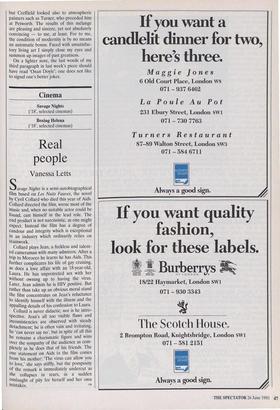Exhibitions
Tony Bevan; Piotr Nathan (Whitechapel Art Gallery, till 11 July) Dennis Creffield: Paintings of Petworth (Gillian Jason, till 9 July)
Myopic conspiracy
Giles Auty
Agreat deal has been written already about the paintings of the 42-year-old artist Tony Bevan at the Whitechapel. A number of critics have portrayed him as the Great White Hope of British figuration, although looking at this exhibition it is rather diffi- cult to see why. However, the artist has powerful dealers in the USA, where the orchestration of critical hype is somewhat easier to arrange. Perhaps our home-bred
critical enthusiasts all mislaid their glasses simultaneously? I do not feel that most of these paintings can bear too much close critical scrutiny.
What is in their favour? They are pre- dominantly large and brightly coloured, occasionally composed intelligently and look as though they ought to have some kind of significance, although no one seems too sure what this might be. Even the oth- erwise astute young critic James Hyman has hazarded some unlikely and sometimes contradictory explanations in the summer edition of the Royal Academy Magazine. When Hyman writes that 'Bevan encour- ages viewers to read their own meanings into his pictures', one suspects this is because viewers may credit them with at least one more meaning than they have. The artist is eclectic and diligent and makes what he imagines are the right picto- rial references — to Munch, Guston and Bacon especially — yet the artist Bevan's inert, check-shined figures brings to mind most strongly is the cartoonist Glenn Bax- ter. The artists to whom Bevan ostensibly pays homage include those who strip away humanity's physical and psychic disguises to reveal rawness and alienation. But `Self Portrait, 1992, acrylic on canvas, by Tony Bevan Bevan apes their mannerisms while having little or nothing to say. Someone should explain that wearing a lion's skin does not make its borrower a lion.
The artist's drawing, as in the matter of hands, is regularly weak and I suspect he cannot create convincing space even were he to wish to do so. An overall feeling of concoction is accentuated by his adoption of shallow-seeming tricks, notably the mix- ing of sand with his paint. Those who know Bevan assure me he is a very agreeable man, so I wish sincerely I could find more to admire in his open-mouthed singers, heads of hair which seem to have lost an argument with an enraged sheep-shearer and use of startling background colours, again in the manner of Francis Bacon. My greatest regret is that I do not feel these are really the artist's own, strongly felt or considered images but merely promotable products for an age of visual illiterates.
The second artist on view at present at the Whitechapel has been financed by the stipend programme of the Berlin Senate for Cultural Affairs and seems typical of so-called artists being shunted around Europe by similar-sounding bodies. Unsur- prisingly, like so many who attract patron- age today, Piotr Nathan is of a conceptual turn of mind and acutely conscious of the world's more fashionable ills. A caption card on the gallery wall purports to help explain one of his installations. This card could hardly be improved upon even if I had sought to invent it for purposes of satire: The outline of the place that was bombed in the last days of the war follows the contour of a urine mark that emerged on the mattress of a person dying of Aids.
Today, to work year in, year out in the world of living art puts serious strain on objectivity, spirit and finally sanity. But for those who manage to retain all three there are great benefits to be enjoyed. Just One of these lies in contemplating the great works of previous centuries, then making valid comparisons with our own. Did Goya or Rembrandt 'encourage viewers to read their own meanings into his pictures '? There was meaning aplenty already, the source of which lay in their authors' great genius and humanity. To find someone even approaching art with high purpose comes as a relief today, whatever the results. I feel this to be true of Dennis_ Creffield, whose paintings and drawings 01 Petworth and other desirable locations can be seen at Gillian Jason (42 Inverness Street, NW1). Creffield was born in 1931 and, like his better-known contemporaries Auerbach and Kossoff, studied with David Bomberg at the Borough Polytechnic. This much should be obvious even to the relatively uninformed onlooker. Bomberg was teacher of Messianic force whose influence seems ineradicable. Here, the emphatic' square-ended line as a kind of structural shorthand provides an unmistakable elite'
but Creffield looked also to atmospheric painters such as Turner, who preceded him at Petworth. The results of this mélange are pleasing and sincere, yet not absolutely convincing — to me, at least. For to me, the condition of modernity is by no means an automatic bonus. Faced with unsatisfac- tory living art I simply close my eyes and summon up images of past greatness.
On a lighter note, the last words of my third paragraph in last week's piece should have read 'Onan Doyle'; one does not like to signal one's better jokes.



























































 Previous page
Previous page